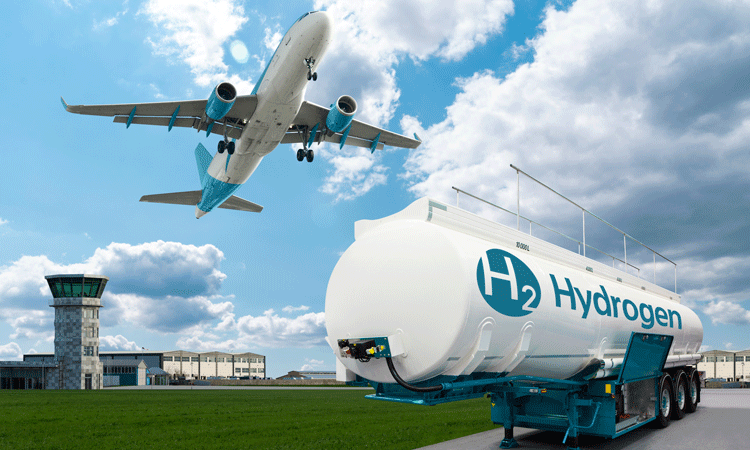How can airports ensure they have the correct infrastructure in place in time for commercial hydrogen aircraft?
Posted: 18 December 2024 | Dr. Josef Kallo | No comments yet
Dr. Josef Kallo, Co-founder and CTO of H2FLY, writes for International Airport Review on how airports can ensure they are ready for hydrogen-powered flight.


Hydrogen aviation is no longer a distant dream – it’s a fast-approaching reality that promises to transform sustainable air travel. While test flights and infrastructure milestones are already being achieved, the success of hydrogen aviation hinges on collaboration with airports. Now we must ask how airports can prepare for this groundbreaking shift and what steps they can take today to ensure they are ready for a hydrogen-powered future?
Earlier in 2024, Airbus announced two significant partnerships with London Gatwick and Kansai Airport. The two airports joined a broader partnership that aims to advance hydrogen solutions in airport operations and infrastructure. While some in the aviation space may look at these choices as a risk, it is a risk that needs to be made if we are to reach our sustainable goals.
Airports are going to play a significant role in the adoption of new sustainable technologies, whether that be hydrogen or something else.”
Airports are going to play a significant role in the adoption of new sustainable technologies, whether that be hydrogen or something else. While some organisations are on the front foot, a lack of real movement could put the wider sustainable mission at risk. Granted, effective action takes long-term vision; whilst investment is necessary now, dividends will be paid further down the line and there are multiple challenges to address.
Addressing the challenges
As hydrogen emerges as a promising fuel for a sustainable future, addressing its logistical complexities is a question that remains posed by many within aviation. The main challenge presented when it comes to hydrogen is storing, handling and transporting it.
Hydrogen can be stored as either a gas at high pressure or a liquid at extremely low temperatures. Both methods require specialised infrastructure. Compressed hydrogen gas requires high-pressure tanks that can handle up to 700 bar of pressure. Alternatively, liquid hydrogen requires cryogenic tanks that maintain temperatures as low as -253°C to keep the hydrogen in liquid form.
When transporting hydrogen within the airport, from storage areas to refuelling points, additional steps are needed to ensure safety. Airports will need to invest in appropriate monitoring systems, such as special pipelines or transport vehicles that comply with new standards. This new infrastructure will additionally require regular inspections and maintenance by trained staff to ensure integrity. But, these protocols would not be widely dissimilar to current kerosene handling processes – and with time would become the norm.
Regardless of the end result, there are many within the industry that remain hesitant. A new infrastructure is costly and requires long-term vision. However, there are ways to lower the initial cost, such as starting with small commitments.
Starting small
To address potential hesitations, the hydrogen industry is exploring flexible solutions like modular hydrogen storage. These smaller, scalable systems allow airports to invest incrementally, starting with compact storage and refuelling set-ups that can expand as demand increases. This approach enables airports to align investment with the growing adoption of hydrogen aviation, ensuring resources are deployed efficiently as the technology gains traction.
Group investment
Another way to mitigate risk is to work together, this is the most obvious strategy if organisations look to share the burden of investment and operational risks. Forming strategic partnerships with key players across the hydrogen network from suppliers and technology companies, is a great way to ensure that airports enter into the hydrogen conversation and begin to take action, without taking on the whole burden themselves.
Real world examples
Once considered a distant dream, hydrogen is set to become a sustainable fuel sooner than many expect.”
Steps have already been taken to ensure success, for example earlier this year, with the partnership between Airbus, easyJet and Gatwick Airport. The current project extends to all aspects of the hydrogen supply chain, from storage at London Gatwick to refuelling and ground handling. The combination of expertise and resources is critical to ensuring that hydrogen technologies are unilaterally accepted as viable options.
Bridging to policy
Despite the clear interest and progress that the industry is making, we also need to consider engaging with government bodies. It’s important to remember that the hydrogen industry is still building an ecosystem. Industry specialists must prioritise raising awareness and educating public bodies on both the benefits of hydrogen and ways to overcome the perceived challenges to ensure commercial success. It is of course, important to demonstrate possible solutions when seeking buy-in from these regulators.
To establish a strong foundation, feasibility studies evaluating specific needs, costs and timelines for hydrogen infrastructure and hydrogen operations are essential in substantiating the key actions required. These studies become even more compelling when complemented by pilot projects, such as the GOLIAT initiative. Participating in such cutting-edge projects offers practical insights into the infrastructure demands and operational adjustments necessary for success.
Now is the perfect time for airports to actively participate, and have a role in shaping regulation directly with governmental bodies. Airports will have a seat at the table and be able to ensure that emerging hydrogen technologies are safe and feasible within their current infrastructure. In addition, it gives organisations a voice when it comes to making sure goals and implementation objectives are measurable and achievable.
The time is now
While there is still a way to go before hydrogen aircraft become widely available, airports that start preparing now will be well positioned for the future. Acting early allows them to avoid being caught unprepared as hydrogen-powered aviation approaches reality. Once considered a distant dream, hydrogen is set to become a sustainable fuel sooner than many expect.
Early engagement also enables airports to play a role in shaping regulations, while spreading out infrastructure investments or securing pioneering partnerships. By adopting a long-term perspective today, airports can position themselves to benefit first from commercially viable hydrogen aircraft.


c: Marijan Murat/dpa/Alamy Live News
Dr. Josef Kallo is the co-founder and CTO of H2FLY, a premier hydrogen propulsion company headquartered in Stuttgart, Germany. As an entrepreneur, he financed the first round of H2FLY, aiming very early for a qualified transfer of technology from basic knowledge to a first flying prototype. Subsequently, H2FLY has integrated multiple generations of hydrogen fuel cell electric powertrain into a passenger aircraft – the HY4.
He has an extensive background in power electronics and energy technologies, with international research collaboration with partners in Japan (JAXA), France (CEA, Onera), and Spain (INTA). From 1999 to 2006, he was a Project Engineer at the General Motors, Global Alternative Propulsion Center, focused on the application of hybrid powertrains as well as a test engineer for hydrogen applications. Since then, he has co-ordinated at the German Aerospace Center numerous development projects focused on battery, fuel cell and hybrid electric powertrain architectures and implementation for aircraft and acted as chairman of the E2Flight electric flight conference from 2014 to 2021. Since 2015, when he was additionally appointed as Full Professor at the University Ulm, he leads research in energy management for hybrid powertrains, and in 2017 assumed the position of Primary Investigator at the Helmholtz Institute for Electrochemical Energy Storage. He is a passionate pilot and holds a doctoral degree in electrical engineering from University of Ulm.
Join our free webinar: Beyond silos: How ecosystem thinking elevates the airport experience
In today’s complex aviation landscape, airports are moving beyond siloed operations to embrace a new era of collaboration. This webinar focuses on how leading airports are using ecosystem thinking to adapt, personalize, and continuously improve every touchpoint, boosting both passenger satisfaction and non-aeronautical revenue.
Date: 13 Nov | Time: 10:00 GMT
REGISTER NOW TO SECURE YOUR SPOT
Can’t attend live? No worries – register to receive the recording post-event.
Related topics
Funding and finance, Green energy, Hydrogen, Regulation and Legislation, Safety, Sustainability
Related airports
Kansai International Airport (KIX), London Gatwick Airport (LGW)

















